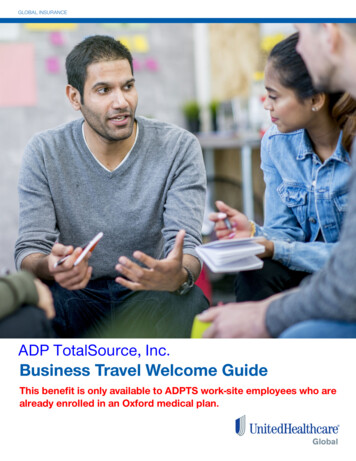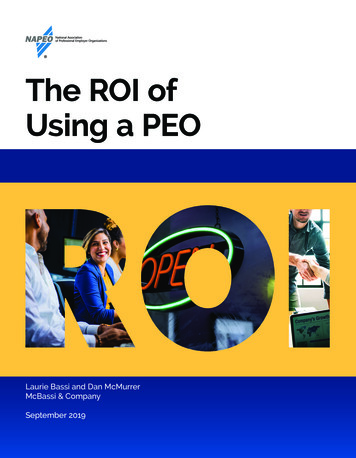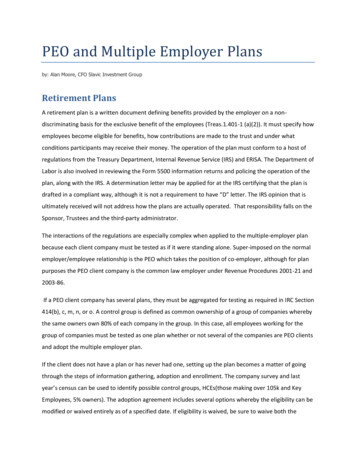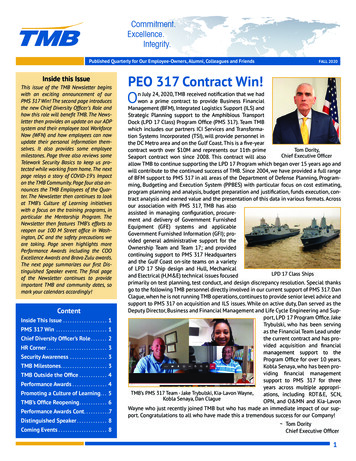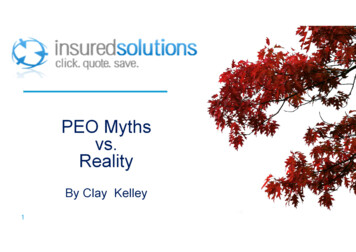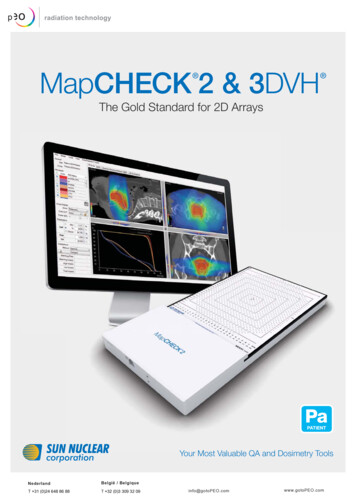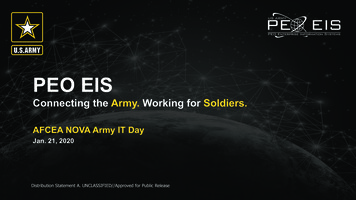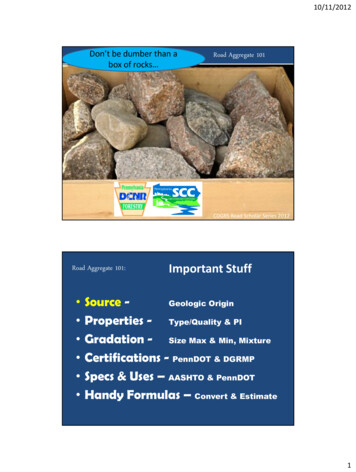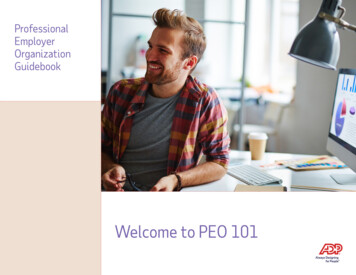
Transcription
ProfessionalEmployerOrganizationGuidebookWelcome to PEO 101
PEO Basics & Key Things YouNeed to KnowQuestion 1Question 6Question 11What is a Professional EmployerOrganization – or PEO?Why should clients considera PEO relationship?Question 2Question 7Can a client relationship with aPEO help a business with HealthCare Reform compliance?PurpleWhat is “co-employment?”What is the difference between temporarystaffing or employee leasing and a PEO?Question 3How does a PEO work?Question 4Who is responsible for payingemployees, employment taxes, andstate unemployment taxes?Question 5How about workers’compensation coverage?Question 8What businesses can benefitfrom a PEO arrangement?Question 9How does a PEO benefitPEO clients?Question 10How does a PEO benefit employees?Conclusion
Question 1What is a Professional EmployerOrganization – or PEO?!Key PointMany PEOs operatein all 50 states.There are about 700PEOs in the UnitedStates.A PEO provides integrated human resources services includingpayroll, tax filing, benefits, workers’ compensation, workplacesafety and human resources guidance and administration to helpsmall businesses manage certain employer responsibilities and risks.A PEO delivers these services by establishing and maintaining aco-employment relationship with the employees at theclient’s worksite.3
Question 2What is “co-employment?”!Key PointApproximately threemillion Americanworkers areemployed undera co-employmentarrangement.In a “co-employment” arrangement, when an organization partners witha PEO, the PEO assumes certain employment responsibilities. The PEOclient maintains control of the day-to-day management of its employeesand its business, just as it did prior to entering the coemploymentrelationship. However, by sharing certain employment responsibilitieswith the PEO, a PEO client is able to stabilize certain employment-relatedexpenses and mitigate some of the liabilities associated with being anemployer, such as compliance with the Affordable Care Act. Minimizingthese types of responsibilities provides more time for PEO clients tofocus on the strategic, revenue-building aspects of their business.4
Question 3How does a PEO work?!Key PointOrganizations that entera PEO relationship do not cedeOnce an organization and a PEO enter into a co-employment relationship,both companies share certain employment responsibilities and thePEO becomes a co-employer along with the client of the clientorganization’s employees.ownership or lose control overtheir business. The PEO typicallyfocuses on employment- relatedareas – such as payroll, HRadministration, taxes associatedwith employment, and benefits –while the PEO client handles The PEO client continues to manage its business and marketingoperations, providing products or services to its buyers. T he PEO processes payroll, withholds and pays payroll taxes, maintainsworkers’ compensation coverage, provides access to employee benefitprograms and provides human resources guidance.the regular operations ofits business.5
Question 4Who is responsible for payingemployees and remittingemployment taxes?PEOs assume the responsibility for processing payroll, and reportingand remitting employment related taxes.However, some PEOs are certified (CPEO) by the IRS under the Small BusinessEfficiency Act (SBESA) and recognized as the employer for federal employmenttax purposes. CPEOs must meet specific requirements regarding tax status,background, experience, business location, financial reporting, and more. Thecertification program also requires a CPEO to post a bond each year of up to 1 million guaranteeing payment of its federal employment tax liabilities.CPEOs are solely responsible for the payment of federal employment taxes.If a company utilizes a non-certified PEO that doesn’t pay their taxes,they could be liable.6
Question 5How about workers’compensation coverage?Typically, a PEO willprovide workers’compensation coverageand claims administrationfor its client’s employees,often referred to as“worksite employees.”7
Question 6Why should clientsconsider a PEO relationship?!Key PointPEO firms report2x higher revenuegrowth compared tonon-PEO firms.2PEOs help their clients stabilize the cost of their labor burden andfocus on improving the bottom line. By assisting PEO clients withroutine administrative tasks and related compliance requirements,a PEO allows its clients to focus more time and resources ontheir core competency.8
Question 7What is the differencebetween temporary staffing oremployee leasing and a PEO?PEOs do not “lease” employees and PEO arrangements should not beconfused with staffing or leasing arrangements. Staffing or leasingPurplecompanies are the sole employer of those employees provided to orleased to the client. In a PEO relationship, the client allocates certainemployer functions to PEOs, who in turn specialize in managing thoseaspects of the employer’s bundle of responsibilities. In this arrangementboth the PEO and the client are co-employers of the employees and bothhave certain rights and obligations with respect to the same group ofemployees who are the client’s employees.9
Question 8What businesses canbenefit from a PEOarrangement?!Key Point98% of PEO clientswould recommenda PEO to a small ormidsized businessMany organizations – regardless of size or type – can benefit froma PEO relationship. While small and midsized organizations are the mostprevalent in PEO relationships, larger organizations are also discoveringthe value of being a PEO client. Moreover, businesses of all types arePEO clients – from manufacturers and accounting firms to physicians andpeople in various trades, such as plumbers, carpenters, and mechanics.colleague.310
Question 9How does a PEO benefitPEO clients?PEOs shoulder the burden of many “non-core” administrative activities – frompayroll to benefits administration – enabling PEO clients to focus morePurple time on theirorganization’s core competency. Further, PEOs that are more sophisticated provideexpertise to help their clients with strategic HR decisions.PEO clients benefit from –3 A ccess to a variety of employee benefit solutions to attractand retain talent3 M itigation of certain employment-related risk throughthe shared responsibility arrangement3 Scalable technology and infrastructure provided via thePEO relationship3 E mployee-related cost stability11
Question 10How does a PEObenefit employees?!Key PointPEO clientsexperience a 10to 14% loweremployee turnoverrate as comparedto the U.S.average.4Employees want access to financial security, attractive benefits(especially a good health care plan), and the opportunity to savefor the future. Studies show that satisfied employees are usuallymore productive, become brand ambassadors for the PEO client,and enhance employee retention rates.12
PEO BenefitsPEO RelationshipIn many cases, a PEO relationship allows employees of small- and midsizedbusinesses to have access to Fortune 500 -caliber benefits Health insurance PEO Benefits Life insurance Retirement savings plans Dental care Educational benefits Vision care E xclusive group discounts on productsand services, and much more. Long- and short-term disability coverage13
Question 11Can a client relationship witha PEO help a business withHealth Care Reform compliance?!Key PointOver 50% think thatthey are currently atrisk of violating atleast one aspect ofannual health carereporting.5While the ACA is in place for now, changes may come around the cornerat any time, and they could be complex. It is important to choose a full servicePEO partner that will ultimately help your organization stay ahead of HealthCare Reform compliance requirements.14
Health Care Reform support froma full-service PEO may include: C reation of IRS annual health careinformation returns (Forms 1094-C and1095-C), filing the information with theIRS, and providing information toPEO clients’employees M anagement of Marketplace/Exchangenotices and appeals C ompliance with reporting thevalue of health coverage on Forms W-2 P ersonalized, ongoing consultation andmanagement of ACA requirements to defineand support each PEO client’s ACAcompliance strategy G eneration of notices of coverage15
Conclusion:Not all PEOs provide the same level of service.So, shop the marketplace for a PEO relationship just as you would for any otherstrategic business need. Do your due diligence. Ask questions. Compare pricing and value.Align your needs with the capabilities that a potential PEO arrangement could provide.Purple1. Select a PEO with a strong financial, compliance and credible client retention record.(Special Tip: Check outwhether a candiate is ESAC acreddited and a Certfied PEO.)2. Assess PEO capabilities based upon how well they can meet the unique needs of yourbusiness and the preferences of your organization’s employees.3. Examine the depth of talent a PEO will provide to support your organization.4. Talk to a PEO’s existing clients, particularly those who are in your business or industry.5. C hoose a PEO that provides comprehensive support – including maximum helpto maintain Health Care Reform compliance.
PEO Evaluation:ChecklistChoosing the right Professional Employer Organization will help your business remainin compliance, leverage the efficiencies of great technology, and facilitate access tocomprehensive capabilities that will benefit your business and its employees.Use this checklist to help you determine the best PEO fit for your organization!m Are you an IRS certified PEO?m How do you charge for your services?m Do you provide a service guarantee?m Will you provide my company withdedicated support team members?m How would you help protect my companyfrom employee lawsuits?m Is your health insurance and workers’compensation insurance fully insured?m Are the benefits premiums you show methe final, underwritten rates?m On average, how long do your clientsremain with you?m W hat is the breadth of your complianceoffering - and are there additional fees?m How often do you enhance yourtechnology platform?m Do you offer worksite employees mobileaccess to their payroll, HR, and benefits data?m How do you manage data security?m Would you put me in contact with severalof your current clients?m How many benefits carriers doyou work with?15
For more information aboutProfessional EmployerOrganizations:Please call 1.800.447.3237or visit www.adptotalsource.comIMPORTANT NOTICE: ADP TotalSource publishes this PEO Guidebook free of charge. It is accepted with the understanding that thepublisher is not engaged in the business of rendering legal or accounting advice/services. Please consult your tax or legal advisorshould you have any questions on the topics presented.1 NAPEO White Paper, “Professional Employer Organizations: Keeping Turnover Low and Survival High,” Dr. Laurie Bassi and Dan McMurrer, 2014.2 NAPEO White Paper, “PEOs: Good for Businesses and Their Employees,” Dr. Laurie Bassi and Dan McMurrer, 2017.3 “Professional Employer Organizations: Fueling Small Business,” September 2013.4 NAPEO White Paper, “Professional Employer Organizations: Keeping Turnover Low and Survival High,” Dr. Laurie Bassi and Dan McMurrer, 2014.5 “ACA Confidence Study,” ADP Study 2016.ADP, the ADP logo, and Always Designing for People are trademarks of ADP, LLC.
What is a Professional Employer Organization – or PEO? Question 1 . Key Point PEOs help their clients stabilize the cost of their labor burden and focus on improving the bottom line. By assisting PEO clients with . IMPORTANT NOTICE: ADP TotalSource publishes this PEO Guidebook free

